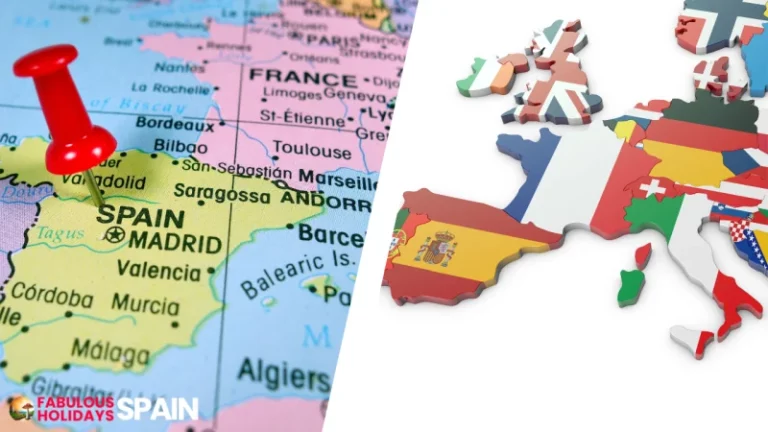Best Time to Visit Spain (Prices, Weather, Crowds) The Ultimate Guide
Hola from Spain!
I’m an expat who’s called Spain home for over a decade, and I’ve had the pleasure of experiencing the country’s diverse culture, regions, and weather patterns firsthand.
Unlike much of the travel advice out there, my insights come from my own lived experiences in Spain.

I’ve spent countless hours researching and gathering details, creating handy graphics, and crafting this deeeetailed guide to help you determine the best time to visit Spain.
By the end of this guide, you’ll clearly understand when to visit Spain to make the most of your adventure.
When’s The Best Time to Visit Spain?
The best times to visit Spain are the months of March to May and September to November.
You’ll find pleasant weather, fewer crowds, lower prices, and more activities you can handle.
Here’s what we’ll discuss:
6 Things to Think About Spanish Vacation
Seasons in Spain
Weather and best time for Spanish destinations
Price and Crowd Trends in Spain
Events to Visit in Spain in Winter
Events to Visit in Spain in Spring
Events to Visit in Spain in Summer
Autumn Events to Visit in Spain
Best time to visit Spain with children
The best times to visit Spain are spring and autumn.
But if we dig into the details, Spain is yours to explore year-round.
Love the beach and soaking up the sun? Summer’s your time to shine.
Prefer exploring cities, hitting the hiking trails, and enjoying cooler temps? Spring or autumn are your sweet spots.
And if you’re a winter sports enthusiast, winter is when Spain’s magic truly unfolds.
Before we discuss the best time to visit Spain please check the official Spanish weather forecast by AEMET.
6 Things to Consider When Choosing Your Spanish Vacation Time
Picking the perfect time for your Spanish adventure can be tricky but don’t worry!
Here are 6 key things to think about when making your decision.

- What kind of trip are you after? Beach bum or sightseeing enthusiast? Spain has something for everyone, from sun-kissed beaches to ancient ruins and bustling cities.
- Weather matters! Spain has diverse climates across its regions. If you’re seeking warm sunshine, head to the south, while those who prefer milder temperatures might enjoy the north or mountains.
- Beat the crowds and save some pounds! Spain’s peak seasons are summer, Easter, and Christmas when prices soar and popular spots get packed. Consider visiting during the shoulder seasons (spring or fall) for a more relaxed and affordable experience.
- Festivals and events galore! Spain is a vibrant country with a packed cultural calendar. Check out what’s on during your desired travel dates; you might stumble upon a lively fiesta or a world-renowned festival. A lifetime memory, I promise!
- Accommodation availability: Planning is crucial, especially during peak seasons when popular destinations fill up quickly. Book your stay in advance to avoid last-minute scrambles.
- Travelling with little ones? Consider the best time based on kid-friendly activities and attractions. Summer offers plenty of outdoor fun, while spring and fall provide milder weather for exploring.
In this article, I will explore these considerations based on my 17-year-long experience to help you find what time is best for you.
The most important factors are climate and seasons. Read on to learn about the weather in Spain so you can pick the perfect time for you!
Seasons in Spain
Spring (March-May)
Mild weather, blossoming scenery, and lively festivals.
Spring is a fantastic time to visit Spain, as the country shakes off its winter slumber. The weather is pleasant, with average temperatures ranging from 10°C (50°F) to 20°C (68°F).

The landscapes are ablaze with colour, with vibrant wildflowers covering the meadows and fruit trees bursting into blossom.
Summer (June-August)
Summer in Spain is a time for fun, sun, and plenty of tourists.
The weather is hot and sunny, with average temperatures reaching 30°C (87°F) and above. The beaches are packed with people swimming, sunbathing, and enjoying the lively atmosphere.
The cities come alive with a vibrant nightlife scene, as people take advantage of the warm summer nights. Get a grip because in Spain in summer night falls at 11 PM!

Spain’s coastline is a paradise for beach lovers, with everything from the cosmopolitan beaches of Barcelona to the idyllic coves of Mallorca. Whether you’re looking for a place to relax and soak up the sun or a place to party all night long, Spain’s beaches are for you.
When the sun sets, the party continues in the tapas bars and lively nightclubs. Spain is well-known for its tapas, and there are endless places to sample these delicious small plates.
The nightclubs are also open late, and there’s always something going on to keep you in action.
If you’re looking for a fun, exciting, and unforgettable summer vacation, summer is for you. Just be sure to book your flights and accommodation early, as it’s a popular destination for tourists from all over the world.
Autumn (September-November)
Pleasant temperatures, vibrant fall foliage, and fewer crowds make autumn a delightful time to visit Spain.

The summer sun-tanned crowds have dispersed, and the weather has settled into a comfortable range, with average temperatures between 15°C (59°F) and 20°C (68°F). There’s nothing like a fresh drink in the autumn breeze in a tapas bar!
The landscapes transform into a breathtaking panorama of colours, as the leaves of deciduous trees don their autumnal attire, painting the countryside in hues of fiery red, warm orange, and golden yellow.
Autumn is also an ideal time to immerse yourself in Spain’s abundance of outdoor activities, such as invigorating hikes, leisurely cycling adventures, and captivating sightseeing excursions.
As harvest season reaches its peak, the air is filled with the tantalizing aromas of fresh, local produce, inviting you to savour the culinary delights of Spain.
Winter (December-February)
Winter in Spain is a season of contrasts, marked by festive cheer, snowy mountain escapes, and the possibility of travel hiccups.

While the coastal areas bask in mild temperatures, hovering around 10°C (50°F), the mountainous regions transform into winter wonderlands, blanketed in snow and beckoning skiers and snowboarders.
The spirit of Christmas and New Year’s Eve fills the air, casting a magical glow over the streets and squares adorned with twinkling lights. Cities burst into life with vibrant celebrations, from the Three Kings Day parade to the colourful Carnival festivities.
However, winter can also bring travel disruptions, as snow and ice can wreak havoc on transportation. Some years with a lot of snow highways can get closed and nobody can pass until they clean the snow. It’s a good idea to stay informed about weather forecasts and be prepared for potential delays or cancellations. Ask me how I know!
Weather and best time to visit major Spanish destinations
Spain is a big country and the weather can differ significantly. Let’s take a look at the major cities and their climate over the years.
What’s the best time to visit Madrid?
The best time to visit Madrid is during the spring (April-May) and fall (September-October). During these months, the weather is pleasant and mild, with average temperatures ranging from the mid-60s to the mid-70s degrees Fahrenheit (15-25°C).

The skies are typically clear and sunny, with little rainfall. This makes it ideal weather for exploring the city’s sights, strolling through its many parks, and enjoying the outdoor cafes that dot the streets.
Summer (June-August) can be hot and crowded in Madrid, with temperatures often soaring into the 90s Fahrenheit (30s Celsius). Some businesses may close for vacation during this time, and prices for hotels and flights tend to be higher.
Summer also brings some of Madrid’s biggest and most vibrant festivals, such as the Fiestas de San Isidro and the Verano madrileño. Ole!
Winter (November-March) is generally mild in Madrid, with average temperatures hovering in the 40s and 50s degrees Fahrenheit (5-10°C). However, it can also be quite rainy and overcast.
This can be a good time to visit if you want to avoid the crowds and save money on accommodations, but be prepared for some unpredictable weather.
Ultimately, the best time to visit Madrid depends on your personal preferences. If you prioritize pleasant weather and outdoor activities, spring and fall are ideal.
If you’re looking for a lively atmosphere and don’t mind the heat and crowds, summer is your choice. And if you’re on a budget and don’t mind unpredictable weather, winter can be a surprisingly pleasant time to visit.
What’s the best time to visit the Balearic Islands?
The best time to visit the Balearic Islands depends on what you’re looking for in a trip. If you want to bask in the sun and soak up the warmth, the summer months (June to September) are the perfect choice.

For milder temperatures and fewer crowds, the shoulder seasons of May, June, September, and October are ideal.
During the summer, the mercury can soar to the high 80s and 90s Fahrenheit (30s Celsius), with plenty of sunshine and little rain. However, this is also the peak tourist season, so expect higher prices and larger crowds.
In spring and autumn, the temperatures are still warm, but not as scorching as in the summer. The crowds are also thinner, and prices are more affordable. This is a great time to enjoy the islands’ many attractions, such as hiking, biking, and swimming.
In the winter, temperatures are mild, with highs in the mid-50s Fahrenheit (around 10 °C). There is more rain in the winter, but it’s still a pleasant time to visit if you don’t mind the cooler weather.
What’s the best time to visit the Canary Islands?
The best time to visit the Canary Islands is all year round.
The summer months, July and August, are the hottest, with average highs of around 28°C (82°F). While these months are also the busiest and most expensive, they’re perfect for those who love warm weather and don’t mind the crowds.

If you’re looking for good weather without the crowds, consider visiting during spring (March-May) or fall (September-November). During these months, the average high temperatures are around 24°C (75°F), and with the strong Spanish sun, the days are delightfully sunny and warm.
No matter when you visit, you’re sure to enjoy the Canary Islands’ mild climate. Average temperatures range from 18°C (64°F) in the winter to 28°C (82°F) in the summer. The islands are also very dry, with an average annual rainfall of only 250 mm (10 inches).
The Canary Islands are a popular destination for tourists from all over the world. The islands are home to a variety of attractions, including beaches, mountains, volcanoes, and national parks. The islands are also known for their beautiful scenery, friendly people, and delicious food.
What’s the best time to visit Catalonia?
The best times to visit Catalonia are spring and autumn when you’ll encounter fewer crowds, lower prices, and a more peaceful experience. During these months, the average temperature is a pleasant 70°F (21°C), and there’s a chance of rain, which adds to the region’s charm.

If you’re seeking warm weather and sunny skies, summer (June to August) is the time to go. The average temperature soars to 82°F (28°C), and rainfall is minimal. However, be prepared for larger crowds during this peak season.
For those who don’t mind cooler temperatures, winter (November to March) offers a unique Catalan experience. The average temperature dips to 50°F (10°C), and the mountains transform into a winter wonderland, perfect for snow sports and enjoying the crisp winter air.
What’s the best time to visit Andalusia?
The best time to visit Andalusia is during the shoulder seasons of spring (March to May) and autumn (September to November) when the weather is delightful and the crowds are fewer.

In spring, the mercury hovers around a comfortable 68 to 77 degrees Fahrenheit (20 to 25 degrees Celsius), with ample sunshine and minimal rain.
It’s the perfect time to get active outdoors like hiking, biking, and exploring the region’s scenic wonders.
Autumn brings slightly cooler temperatures, with averages ranging from 64 to 73 degrees Fahrenheit (18 to 23 degrees Celsius).
The skies remain sunny and dry, making it an ideal time to hit the beaches and immerse yourself in the vibrant festivals that come alive throughout Andalusia.
The summer months (June to August) can be sizzling, with temperatures often soaring into the mid-90s Fahrenheit (over 35 degrees Celsius). This can make sightseeing a bit challenging, especially in the bustling cities.
However, if you’re seeking a sun-kissed beach getaway, summer is your prime time, as the waters are invitingly warm and the beaches are abuzz with energy.
Winter in Andalusia (December to February) is mild, with average temperatures ranging from a crisp 50 to 60 degrees Fahrenheit (10 to 16 degrees Celsius).
While rainfall increases during this time, it’s still a pleasant season to visit, especially if you prefer a less crowded Andalusian experience.
What’s the best time to visit Valencia?
The most pleasant time to experience Valencia is during the shoulder seasons of spring (March to May) and autumn (September to November).

The weather tends to be mild and sunny, with average temperatures ranging from a comfortable 68 to 77 degrees Fahrenheit (20 to 25 degrees Celsius).
These months offer the advantage of enjoying the city’s outdoor attractions without the throngs of tourists and the humidity that comes with the summer months.
Valencia’s peak season is during the summer months (June to August), when the weather is hot, humid (better said, ridiculously humid), and sunny, with average temperatures reaching a toasty 86 degrees Fahrenheit (30 degrees Celsius). And more!
This is the ideal time to visit if you’re seeking to soak up the sun on the beaches and enjoy outdoor activities. However, be prepared for larger crowds and higher prices during this time.
Winter in Valencia (November to March) is the mildest winter in Spain, with average temperatures ranging from a cool 50 to 60 degrees Fahrenheit (10 to 15 degrees Celsius). No exaggeration, here in Valencia winter feels like spring!
This is a good time to visit if you prefer to avoid the crowds and enjoy lower prices.
However, keep in mind that there may be more rain during these months. Rainfall patterns can vary from year to year, so it’s advisable to check the online forecast before packing your bags.
My first-hand experience of the last 5 years is that it rains close to nothing.
Price and Crowd Trends in Spain
Spain’s popularity can make it a crowded and expensive destination, especially during peak season. But don’t fret, there are plenty of ways to sidestep the crowds and save money on your Spanish adventure. Here’s an insider guide to planning your trip with crowds and costs in mind.
Crowd Trends
To help you visualize the ebb and flow of tourist numbers, I’ve prepared detailed charts showcasing international tourist arrivals in Spain from January 2022 to September 2023. These charts will help you identify periods with fewer crowds, allowing you to plan your trip accordingly.
Tourist arrivals in millions in Spain for the period of January 2022 to September 2023.
Spain has been welcoming more and more visitors in recent years, and its tourism industry is bouncing back strongly after the COVID-19 pandemic.
The peak season for tourism in Spain is during the summer months of July and August when the weather is hot and sunny. However, many tourists also choose to visit Spain in the spring and autumn, when the weather is milder and accommodation prices are more reasonable.

If you’re planning a trip to Spain, it’s important to be aware of the potential for crowds. The most popular tourist destinations are likely to be busy, especially during the summer months. If you’re looking for a more laid-back vacation, you might want to consider visiting Spain in the spring or fall, when there are fewer crowds.
Spain Tourists by Autonomous Community By Month
The charts below show how many international tourists visited each of Spain’s autonomous communities. This will give you a better idea of how crowded your destination might be.
Spain’s most popular tourist destinations, the Balearic Islands and Catalonia tend to be packed with visitors, followed by Andalusia. The Canary Islands, while not as bustling as the other three, still attract more tourists than Valencia and Madrid.
The Canary Islands stand out as the only region in Spain where winter tourism surpasses summer tourism. This stems from its mild climate, a welcome respite for those seeking refuge from the frigid European and American winters.
Spain’s tourist influx peaks during the summer months (June to August) and dips to its lowest point during the winter months (December to February).
While Spain’s weather is generally pleasant throughout the year, summer’s beaches and outdoor activities make it a particularly enticing destination for tourists.
Crowds and Prices in Winter
Crowds: Winter is the least popular time for tourists to visit Spain, so you can expect to see very few crowds.
Prices: Prices for accommodation and flights are at their lowest in winter. You can also find great deals on hotels and flights if you book your travel in advance.
Crowds and Prices in Spring
Crowds: Spring is a great time to visit Spain, as the weather is pleasant and the crowds are smaller than in summer.
Prices: Prices for accommodation and flights start to rise in spring, but they’re still not as high as in summer. You can also save money by visiting during March or May when the weather is nice but the crowds are smaller.
Crowds and Prices in Summer
Crowds: Summer is the most popular time to visit Spain, so expect to see crowds at popular tourist destinations. However, there are still ways to beat the crowds.
Plan your visit during the week, when the crowds are smaller. If you visit beach areas go to the beach early in the morning or late in the afternoon.
A good time to avoid crowds is during siesta time between 2 and 5 PM.
Keep in mind the sun is hot and you’ll need the shade of a sun umbrella, sunglasses, plenty of sunscreens, a bright shirt, and water.
Prices: Prices for accommodation and flights are at their peak in summer. However, you can still find deals if you book your travel well in advance or if you’re flexible with your travel dates.
Consider staying in a neighbourhood that’s a little off the beaten path. Spain has a great transport network and an additional 15 minutes of driving in a bus or Uber can save you quite some money.
Crowds and Prices in Autumn
Crowds: The crowds start to thin out in autumn, making it a great time to visit Spain. Visit during September, October, or November, when the weather is still nice but the crowds are even smaller.
Prices: Prices for accommodation and flights start to decline in autumn. You can also find great deals on hotels and flights if you book your travel in advance.
Prices of Accommodation in Spain
Prices for tourist accommodation in Spain vary depending on the time of year. The most expensive time to visit is during the summer months (July and August) when the weather is at its best and the beaches are crowded.
The cheapest time to visit is during the winter months (November to February) when the weather is cooler and there are fewer tourists.
Best Time To Visit Spain Based on Accommodation Price
- Book your accommodation in advance, especially if travelling during the peak season.
- Consider staying outside the city centre, where prices are typically lower.
- Look for deals and discounts on accommodation websites and travel blogs.
- Stay in a hostel or B&B on a tight budget.
- Consider renting an apartment if you are staying for a longer period or with a bigger family.
This one is easy to spot. The closer to summer, the higher prices of accommodations will be. For absolute bargain choose January and for affordable rates choose spring or fall.
The most expensive month to stay in Spain is July, when the average price for all accommodation types is €148.33. The least expensive month to stay is December, when the average price is €114.33.
The average price for hotels in Spain is €143.67 per night. This is the most expensive type of accommodation, followed by holiday homes (€140.50), apartments (€111.83), and B&Bs (€88.17).
Events to Visit in Spain in Winter
Three Kings Parade
On January 5th, the streets of Spain come alive with a joyous celebration as the Three Kings – Melchior, Gaspar, and Balthasar – make their grand entrance.

Children and adults alike eagerly await their arrival, lining the streets with anticipation as the colourful cavalcade approaches.
This magical spectacle, known as the Cabalgata de Reyes, marks the end of the Christmas season in Spain and is a must-see event.
As the Kings make their way through the city, they shower the excited crowds with gifts and sweets, spreading joy and laughter wherever they go.
The Three Kings Parade is a deeply rooted tradition in Spain, with each city putting on its own unique and elaborate display.
In Madrid, over 2 million people gather each year to witness the parade, while Seville proudly boasts a budget of over €1 million for its festivities.
The event is even broadcast live on Spanish television, captivating millions of viewers nationwide.
The Three Kings Parade is a heartwarming celebration that captures the spirit of Christmas in Spain. It’s a time for families to come together, for children to dream big, and for everyone to revel in the magic of the season.
So, if you find yourself in Spain around January 5th, be sure to catch a glimpse of the Three Kings Parade – it’s an unforgettable experience that will leave you feeling enchanted and full of holiday cheer.
Carnival
More fiesta! Carnival, held in February or March depending on the region, is a time when Spain’s streets come alive with a riot of colour, music, and dance.

While Venice and Rio de Janeiro may be famous for their Carnival celebrations, Spain’s festivities are no less exciting, with each region boasting its unique traditions and customs.
From the elaborate costumes and funny floats of the Tenerife Carnival to the lively parades and traditional masks of the Cádiz Carnival, Spain’s Carnival is a sensory overload.
The Tenerife Carnival attracts over 2 million visitors each year, making it one of the most popular Carnival celebrations in the world.
The Cádiz Carnival is known for its over 120 different chirigotas – satirical musical groups that sing and perform throughout the festivities.
The Águilas Carnival in Murcia features a unique “battle of the confetti,” where participants throw tons of confetti at each other in a playful display of camaraderie.
Christmas Markets
Throughout December, Spain’s cities and towns transform into charming Christmas markets, brimming with traditional stalls that offer an array of goodies, from handcrafted ornaments and local delicacies to festive decorations and seasonal treats.

The air is filled with the enticing aroma of roasted chestnuts and mulled wine, while carolers serenade passersby with heartwarming holiday tunes, creating a truly enchanting atmosphere.
These magical markets draw over 10 million visitors each year, eager to immerse themselves in the festive spirit that envelops Spain during this special time of year.
The Barcelona Christmas Market, Fira de Nadal, stands as one of the largest and most popular in Europe, attracting visitors from all corners of the globe.
Its vibrant stalls overflow with an assortment of treasures, from intricately crafted ornaments to delectable local treats, perfectly capturing the essence of Catalan Christmas traditions.
Meanwhile, the Malaga Christmas Market, Mercado de Navidad, charms visitors with its traditional nativity scenes and handcrafted ornaments, each piece lovingly created by local artisans.
The market’s festive atmosphere is further enhanced by the enticing aroma of roasted chestnuts and the heartwarming melodies of carolers, making it a true delight for the senses.
Events to Visit in Spain in Spring
Las Fallas de Valencia in March
Las Fallas de Valencia is a world-renowned festival that transforms the city into a dazzling spectacle of fire and art. Over 350 monumental papier-mâché ninots (figures) fill the streets, each one a satirical commentary on current events or social issues.

The climax arrives on the night of La Cremà, where these towering creations are set ablaze in a mesmerizing display of fireworks and flames.
- Over 2 million tourists attend Las Fallas in 2023
- The ninots can reach heights of up to 30 meters
- The festival is a UNESCO Intangible Cultural Heritage Site
Semana Santa in April
Semana Santa, or Holy Week, is a deeply religious and cultural event celebrated throughout Spain.
Solemn processions weave through the streets, accompanied by the rhythmic beats of drums and the mournful melodies of saetas.

The air is filled with incense and the scent of orange blossoms, creating a captivating atmosphere of devotion and reflection.
- Seville’s Semana Santa is considered one of the most spectacular in Spain.
- The processions can last for hours, with elaborate floats carrying sacred statues.
- Semana Santa is a time for reflection and spiritual renewal.
Feria de Abril de Sevilla in April
The Feria de Abril is a vibrant celebration of Andalusian culture, transforming Seville into a sea of flamenco dancers, colourful trajes de flamenca, and lively horse-drawn carriages. The air is filled

- The Feria de Abril is one of the largest festivals in Spain with over 2 million visitors.
- The festival is a showcase of flamenco dancing, with impromptu performances throughout the fairground.
- The trajes de flamenca, adorned with vibrant colours and intricate ruffles, are a symbol of Andalusian heritage.
Events to Visit in Spain in Summer
San Fermín Festival, Pamplona in July
The San Fermín Festival, held in the northern city of Pamplona, is a world-renowned celebration of bullfighting, music, and revelry.

The highlight of the festival is the “encierro,” or running of the bulls, where brave participants dash through the narrow streets of Pamplona alongside a herd of bulls.
- The San Fermín Festival attracts over 1 million visitors each year.
- The “encierro” lasts for about 850 meters and takes place at 8:00 am each morning.
- Participants should wear comfortable running shoes and avoid wearing red clothing, which could provoke the bulls.
La Tomatina in Buñol near Valencia in August
La Tomatina is a unique and chaotic food fight held in the small town of Buñol, Valencia. Participants throw over 150,000 tomatoes at each other in a massive tomato-throwing frenzy.

- La Tomatina lasts for about an hour and takes place at noon on the last Wednesday of August.
- Participants are advised to wear protective clothing and goggles to avoid injury from tomato projectiles.
- The town of Buñol is cleaned up by fire trucks after the event.
Sonar Festival, Barcelona in June
Sonar Festival is an international electronic music festival held in Barcelona, attracting music lovers from around the world. The festival features a diverse lineup of DJs, musicians, and artists, showcasing the latest trends in electronic music.
- The Sonar Festival has been held in Barcelona since 1994.
- The festival takes place over three days at various venues throughout the city.
- Sonar Festival also features a conference on technology and creativity, Sonar+D.
More summer events to consider in Spain
- BBK Live, Bilbao in July: A rock, indie, and pop music festival held in the northern city of Bilbao.
- Benicàssim International Festival FIB in July: A popular music festival held in the coastal town of Benicàssim, featuring a mix of international and Spanish artists.
Autumn Events to Visit in Spain
La Mercè Festival, Barcelona in September
Barcelona’s biggest and most beloved festival, La Mercè, honours the city’s patron saint, Our Lady of Mercy.

Over a week, the city comes alive with a whirlwind of events, including colourful parades, traditional music and dance performances, breathtaking castellers (human towers), and spectacular fireworks displays.
- Over 2 million visitors attend the festival each year.
- The festival features more than 100 different events.
- The castellers can reach up to 8 stories tall.
Castañada, Catalonia in November
On All Saints’ Day, Catalonians gather for Castañada, a traditional autumn feast filled with roasted chestnuts, sweet potatoes, and panellists, a type of marzipan confection.
Families and friends gather around bonfires, sharing stories and enjoying the warm glow of the flames.

- Castañada is celebrated throughout Catalonia, with particularly large gatherings in Barcelona and Tarragona.
- The festival’s origins date back to pagan harvest celebrations.
- Castañada is a time for families and friends to unite and honour their ancestors.
Spain Holidays to Consider
Spain has a variety of national holidays throughout the year, each with its unique traditions and celebrations.
It’s a good idea to be aware of these holidays so you can avoid any potential disruptions to your travel plans and also experience the local culture.
| Holiday | Date | Day |
|---|---|---|
| New Year’s Day | 01-01-2024 | Monday |
| Three Kings | 01-06-2024 | Saturday |
| Good Friday | 03-29-2024 | Friday |
| Labour Day | 05-01-2024 | Wednesday |
| Assumption of the Virgin | 08-15-2024 | Thursday |
| National Day of Spain | 10-12-2024 | Saturday |
| All Saints’ Day | 11-01-2024 | Friday |
| Spanish Constitution Day | 12-06-2024 | Friday |
| Nativity of the Lord | 12-25-2024 | Wednesday |
In addition to these national holidays, many regional and local holidays are celebrated in Spain.
These holidays vary from region to region, so it’s best to check with the local tourist office for more information.
Here are some tips for planning your trip to Spain during a national holiday:
- Heads up! Some shops and attractions may be closed or have shorter hours on national holidays.
- Book ahead! Accommodation and transportation prices tend to skyrocket and availability becomes limited during peak seasons, so make sure to secure your spot early.
- Expect crowds! Brace yourself for larger crowds, especially at popular tourist hotspots.
- Embrace the fiesta! Soak up the vibrant atmosphere and immerse yourself in the numerous cultural events and celebrations that take place during national holidays.
Best time to visit Spain with children
Spain holds a special charm for every member of your family. Choosing the right time to visit this captivating country can make all the difference in creating an unforgettable trip for all ages.

Spain’s diverse regions offer a variety of experiences tailored to families. For those who love the beach, the Costa Brava and Costa Dorada boast family-friendly resorts and gentle waves.
For a cultural adventure, Andalusia’s cities like Seville and Granada showcase the fascinating history and architectural marvels kids love.
And for nature enthusiasts, the Pyrenees and Picos de Europa mountains offer breathtaking scenery and outdoor adventures.
Spring with kids
Spring offers family-friendly activities, from hiking to witnessing the spectacle of the Seville Fair, a vibrant celebration of Andalusian culture.
Summer with kids
In summer select the seaside lifestyle with family-friendly resorts, water sports adventures, and the opportunity to try delicious tapas and ice cream.
Autumn with kids
Autumn in Spain is perfect for exploring ancient castles, wandering through charming villages, and witnessing the vibrant hues of autumn foliage. The mild temperatures, ranging from 18°C to 25°C, make it an ideal time for outdoor activities like hiking and cycling.
Winter with kids
Temperatures in winter can dip, especially in mountainous regions, while cities like Madrid and Barcelona transform into winter wonderlands, with twinkling lights and lively Christmas markets.
Join the holiday spirit with ice skating rinks, cosy cafes, and the opportunity to experience traditional Spanish Christmas customs.
What’s The Hottest Month to Visit Spain
The hottest month in Spain is July, when temperatures can reach up to 40°C (104°F) in some parts of the country. If you’re planning to visit Spain during the summer, be sure to pack for hot weather and drink plenty of water.
When Do Most Tourists Visit Spain?
The most popular time to visit Spain is during the summer months (June to August). This is when the weather is at its best and there are plenty of festivals and events taking place.
Summer is also the busiest time of year, so if you’re looking for a more peaceful vacation, you may want to consider visiting in the shoulder seasons (April to May or September to October).
What’s The Cheapest Time to Go to Spain
The cheapest time to visit Spain is in the winter months (November to March). This is when the weather is cooler and there are fewer tourists, so prices for flights and accommodation are lower.
When Is The Rainy Season in Spain?
The rainy season in Spain varies depending on the region. In general, the north of Spain is wetter than the south, and the rainy season typically runs from October to May.
Spain has a Mediterranean climate, so even during the rainy season, there are still plenty of sunny days and the weather is mostly beautiful.
When Is The Worst Time to Visit Spain
The busiest time to visit Spain is in the middle of the summer (July and August). This is when the weather is at its hottest and there are the most tourists.
What Month Is Cheapest to Fly to Spain from the UK?
The cheapest month to fly to Spain from the UK is usually in November or February. However, prices can vary depending on the airline and the time of year.
When Is The Best Time to Visit the Beaches in Spain
The best time to visit the beaches in Spain is in the summer months (June to August) when the water is warm and there are plenty of sunny days.
For a more peaceful beach vacation, you may want to consider visiting in April, May, September, or October when there are fewer crowds.
Conclusion: The Best Time to Visit Spain
The best time to visit Spain depends on what you want to see and do. However, in general, the best time to visit Spain is in the spring (March to May) or fall (September to November) when the weather is pleasant and there are fewer crowds.







One Comment